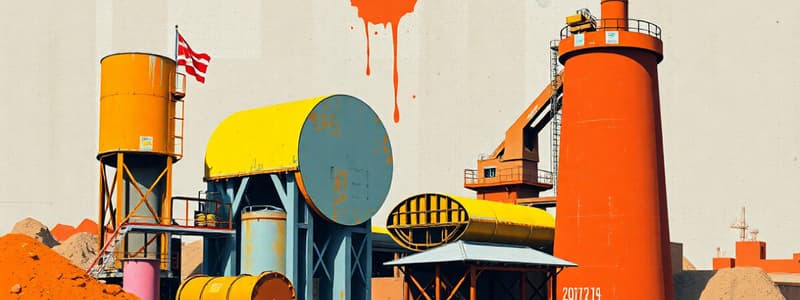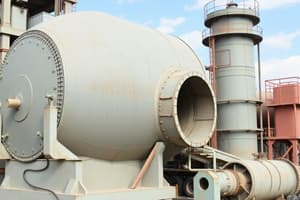Podcast
Questions and Answers
El cemento actúa como un conglomerante hidráulico que fragua al contacto con el agua.
El cemento actúa como un conglomerante hidráulico que fragua al contacto con el agua.
True (A)
El clinker es el resultado final de la mezcla de yeso y cemento.
El clinker es el resultado final de la mezcla de yeso y cemento.
False (B)
La prehomogenización permite una dosificación más uniforme de los componentes del cemento.
La prehomogenización permite una dosificación más uniforme de los componentes del cemento.
True (A)
La mayor parte de las cementeras en España utilizan el proceso de vía húmeda para fabricar cemento.
La mayor parte de las cementeras en España utilizan el proceso de vía húmeda para fabricar cemento.
El alita representa entre el 50% y el 70% del clinker y es crucial para el endurecimiento del cemento.
El alita representa entre el 50% y el 70% del clinker y es crucial para el endurecimiento del cemento.
El horno de clinker opera a una temperatura máxima de 1000°C.
El horno de clinker opera a una temperatura máxima de 1000°C.
El belita constituye alrededor del 15% al 30% del clinker y se hidrata rápidamente.
El belita constituye alrededor del 15% al 30% del clinker y se hidrata rápidamente.
La fase aluminato es responsable de la necesidad de reguladores de fraguado en el cemento.
La fase aluminato es responsable de la necesidad de reguladores de fraguado en el cemento.
Los geopolímeros se caracterizan por tener una estructura cristalina a temperatura ambiente.
Los geopolímeros se caracterizan por tener una estructura cristalina a temperatura ambiente.
La velocidad de hidratación del cemento Portland no afecta su resistencia.
La velocidad de hidratación del cemento Portland no afecta su resistencia.
El clinker se enfría inmediatamente después de salir del horno mediante aire frío.
El clinker se enfría inmediatamente después de salir del horno mediante aire frío.
Los cementos tipo I se utilizan principalmente en estructuras expuestas a sulfatos.
Los cementos tipo I se utilizan principalmente en estructuras expuestas a sulfatos.
El calor de hidratación del cemento se considera tanto por su velocidad como por el total liberado.
El calor de hidratación del cemento se considera tanto por su velocidad como por el total liberado.
El cemento tipo III se usa cuando se requiere alta resistencia en edades tempranas.
El cemento tipo III se usa cuando se requiere alta resistencia en edades tempranas.
La proporción ideal de agua/cemento para buena resistencia es 0.5.
La proporción ideal de agua/cemento para buena resistencia es 0.5.
El proceso de fabricación de geopolímeros incluye la reacción con una solución alcalina.
El proceso de fabricación de geopolímeros incluye la reacción con una solución alcalina.
El clinker se mezcla con cenizas volantes y puzolanas en el proceso final de molienda.
El clinker se mezcla con cenizas volantes y puzolanas en el proceso final de molienda.
La molienda del clinker en molinos de bolas produce cemento en polvo fino y homogéneo.
La molienda del clinker en molinos de bolas produce cemento en polvo fino y homogéneo.
El cemento Portland aumenta su resistencia a medida que pasa el tiempo desde la hidratación.
El cemento Portland aumenta su resistencia a medida que pasa el tiempo desde la hidratación.
El clinker se almacena en silos después de ser enfriado, antes de su molienda.
El clinker se almacena en silos después de ser enfriado, antes de su molienda.
El cemento tipo V es adecuado para construcciones en contacto con suelos y aguas subterráneas.
El cemento tipo V es adecuado para construcciones en contacto con suelos y aguas subterráneas.
Un exceso de agua en la mezcla inicial del cemento mejora la resistencia.
Un exceso de agua en la mezcla inicial del cemento mejora la resistencia.
El cemento se transporta a través de cintas transportadoras desde la cantera hasta la fábrica.
El cemento se transporta a través de cintas transportadoras desde la cantera hasta la fábrica.
Los molinos verticales y de bolas son las únicas máquinas utilizadas en la molienda del cemento.
Los molinos verticales y de bolas son las únicas máquinas utilizadas en la molienda del cemento.
La belita reacciona en la segunda fase de hidratación del cemento.
La belita reacciona en la segunda fase de hidratación del cemento.
El humo de sílice se emplea para mejorar las propiedades del cemento.
El humo de sílice se emplea para mejorar las propiedades del cemento.
La alita es estable en todas las temperaturas del proceso de cocción.
La alita es estable en todas las temperaturas del proceso de cocción.
La proporción de agua/cemento de 0.38 es suficiente para lograr una mezcla adecuada.
La proporción de agua/cemento de 0.38 es suficiente para lograr una mezcla adecuada.
El cemento tipo IV tiene bajo calor de hidratación y buena resistencia a sulfatos.
El cemento tipo IV tiene bajo calor de hidratación y buena resistencia a sulfatos.
El clínker se forma a partir de reacciones químicas que ocurren a 1500ºC.
El clínker se forma a partir de reacciones químicas que ocurren a 1500ºC.
Las cementeras españolas usan preferentemente combustibles alternativos como el gas natural.
Las cementeras españolas usan preferentemente combustibles alternativos como el gas natural.
El enfriador de clínker utiliza aire frío del exterior para reducir su temperatura rápidamente.
El enfriador de clínker utiliza aire frío del exterior para reducir su temperatura rápidamente.
La fase ferrítica representa el 5-15% del clinker y proporciona estabilidad volumétrica.
La fase ferrítica representa el 5-15% del clinker y proporciona estabilidad volumétrica.
Los geopolímeros se caracterizan por sus altas emisiones de CO2 en la producción.
Los geopolímeros se caracterizan por sus altas emisiones de CO2 en la producción.
El cemento tipo III es adecuado para construcciones de rápido fraguado y resistencia.
El cemento tipo III es adecuado para construcciones de rápido fraguado y resistencia.
El aire caliente del enfriador de clinker se reutiliza para mejorar la eficiencia.
El aire caliente del enfriador de clinker se reutiliza para mejorar la eficiencia.
La homogeneización se realiza antes de la molienda del crudo.
La homogeneización se realiza antes de la molienda del crudo.
La reacción entre el aluminato y el agua libera calor rápidamente.
La reacción entre el aluminato y el agua libera calor rápidamente.
Los geopolímeros se producen mediante reacción con una solución alcalina.
Los geopolímeros se producen mediante reacción con una solución alcalina.
Los geopolímeros tienen menor resistencia térmica comparados con el cemento Portland.
Los geopolímeros tienen menor resistencia térmica comparados con el cemento Portland.
El cemento tipo IV se usa en construcciones que requieren bajo calor de hidratación.
El cemento tipo IV se usa en construcciones que requieren bajo calor de hidratación.
El cemento tipo I desarrolla una mayor resistencia a la acción de los sulfatos.
El cemento tipo I desarrolla una mayor resistencia a la acción de los sulfatos.
La proporción de agua/cemento de 0.5 es óptima para la mezcla de cemento.
La proporción de agua/cemento de 0.5 es óptima para la mezcla de cemento.
La fabricación de cemento utiliza principalmente materias primas como calizas y margas.
La fabricación de cemento utiliza principalmente materias primas como calizas y margas.
El proceso de vía seca es más eficiente que la vía húmeda en consumo de energía.
El proceso de vía seca es más eficiente que la vía húmeda en consumo de energía.
Los geopolímeros son altamente resistentes a productos químicos.
Los geopolímeros son altamente resistentes a productos químicos.
El clinker tiene una temperatura de entrada al horno de alrededor de 1000°C.
El clinker tiene una temperatura de entrada al horno de alrededor de 1000°C.
El cemento tipo II tiene un moderado calor de hidratación.
El cemento tipo II tiene un moderado calor de hidratación.
El cemento tipo V ofrece resistencia en suelos con altos contenidos de sulfatos.
El cemento tipo V ofrece resistencia en suelos con altos contenidos de sulfatos.
El cemento endurece sin necesidad de agua, únicamente con calor.
El cemento endurece sin necesidad de agua, únicamente con calor.
Flashcards
Cemento como conglomerante
Cemento como conglomerante
El cemento endurece al mezclarse con agua, formando un material fuerte y duradero.
Clinker vs. Yeso
Clinker vs. Yeso
El clinker se produce antes del yeso, y es una parte fundamental para hacer cemento.
Prehomogenización
Prehomogenización
Proceso que asegura una mezcla uniforme de componentes del cemento.
Proceso de fabricación cemento España
Proceso de fabricación cemento España
Signup and view all the flashcards
Alita en el clinker
Alita en el clinker
Signup and view all the flashcards
Temperatura Horno Clinker
Temperatura Horno Clinker
Signup and view all the flashcards
Belita - Hidratación lenta
Belita - Hidratación lenta
Signup and view all the flashcards
Controladores de fraguado
Controladores de fraguado
Signup and view all the flashcards
Estructura Geopolímeros
Estructura Geopolímeros
Signup and view all the flashcards
Velocidad hidratación vs. resistencia
Velocidad hidratación vs. resistencia
Signup and view all the flashcards
Clinker Tipo I vs. Sulfatos
Clinker Tipo I vs. Sulfatos
Signup and view all the flashcards
Agua/Cemento Proporción
Agua/Cemento Proporción
Signup and view all the flashcards
Procesos para los Geopolímeros
Procesos para los Geopolímeros
Signup and view all the flashcards
Study Notes
General Cement Information
- Cement acts as a hydraulic binder, hardening when mixed with water, creating durable construction material.
- Clinker is a key component in cement production, not a mixture of cement and gypsum.
- Pre-homogenization improves the consistency of cement mixture components.
- Spanish cement plants often utilize a dry process for manufacturing.
- Alit constitutes a significant portion (50-70%) of clinker, vital for cement's hardening.
- Clinker kilns operate at high temperatures (up to 1500°C), enabling chemical reactions.
- Belite, composing 15-30% of clinker, hydrates more slowly, contributing to long-term strength.
- The aluminate phase requires setting regulators in cement production.
- Geopolymers exhibit an amorphous structure at ambient temperatures, transitioning to crystalline at higher temperatures.
- Cement hydration rate directly affects its strength.
- Clinker cools down after leaving the kiln using air.
Additional Cement Properties
- Cement Type I is a general-purpose cement.
- Type II cement is more resistant to sulfates.
- Hydration heat in cement is a factor in both the rate and total amount.
- Ratio of 0.5 water-to-cement is ideal for strength.
- Geopolymer production involves reaction with an alkaline solution.
- Clinker is ground into a fine powder for use in final cement.
- Portland cement increases its strength over time after hydration.
- Clinker is stored in silos prior to grinding into cement.
- Type V cement is effective in environments with high sulfate concentration.
- Water excess during initial mix reduces cement strength.
Manufacturing and Transportation
- Cement is transported from the quarry to the plant using conveyor belts.
- Multiple milling methods (vertical and ball mills) are used to produce fine cement powder.
- Using silica fume improves cement properties.
- Cement production uses different processes depending on conditions and needs.
- Clinker temperature increases gradually during processing in the kiln, reaching up to 1500°C.
- Cement type IV requires low hydration heat for applications such as dams.
- Type I cement is suitable for general construction purposes.
- Type II cement is recommended for applications resistant to sulfate attack.
- Type III cement is useful for rapid-setting applications.
- Type V cement is suitable for sulfates-rich environments.
Studying That Suits You
Use AI to generate personalized quizzes and flashcards to suit your learning preferences.




